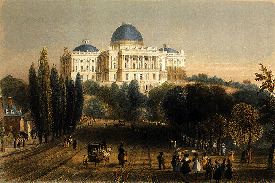The Sixteenth United States Congress was a meeting of the legislative branch of the United States federal government, consisting of the United States Senate and the United States House of Representatives. It met in Washington, D.C. from March 4, 1819, to March 4, 1821, during the third and fourth years of James Monroe's presidency. The apportionment of seats in the House of Representatives was based on the Third Census of the United States in 1810. Both chambers had a Democratic-Republican majority.
A "speech for Buncombe County, North Carolina" given by North Carolina representative Felix Walker in 1820 was credited with introducing into the language the term "bunkum".March 6, 1819: McCulloch v. Maryland: Supreme Court ruled that the Bank of the United States is constitutional.July 3, 1820: United States House of Representatives elections, 1820 began in LouisianaAugust 7, 1820: 1820 United States Census conducted, eventually determining a population of 9,638,453, of which 1,538,022 were slaves.December 3, 1820: U.S. presidential election, 1820: James Monroe was re-elected, virtually unopposed.March 6, 1820: Missouri Compromise, Sess. 1, ch. 22, 3 Stat. 545April 24, 1820: Land Act of 1820, Sess. 1, ch. 51, 3 Stat. 566Tallmadge Amendment would bar slaves from the new state of Missouri. Passed the House of Representatives, but not the Senate. The Tallmadge Amendment led to the passage of the Missouri Compromise.February 22, 1819: Adams-Onís Treaty (Transcontinental Treaty of 1819): Spain ceded Florida to the United States.States admitted and territories created
July 4, 1819: Arkansas Territory was created, 3 Stat. 493. It was formerly part of the Missouri Territory.December 14, 1819: Alabama was admitted as the 22nd state, 3 Stat. 492.March 15, 1820: Maine was admitted as the 23rd state. It was formerly the District of Maine, part of Massachusetts, 3 Stat. 544.The count below identifies party affiliations at the beginning of the first session of this congress. Changes resulting from subsequent replacements are shown below in the "Changes in membership" section.
During this congress, two Senate seats were added for each of the new states of Alabama and Maine.
During this congress, one House seat was added for the new state of Alabama and one seat was reapportioned from Massachusetts to the new state of Maine. For the beginning of the next congress, six more seats from Massachusetts would be reapportioned to Maine.
President: Daniel D. Tompkins (DR)President pro tempore: James Barbour, (DR), until December 26, 1819John Gaillard, (DR), elected January 25, 1820Speaker: Henry Clay (DR), until October 28, 1820John Taylor, (DR), elected November 15, 1820This list is arranged by chamber, then by state. Senators are listed in order of seniority, and Representatives are listed by district.
Skip to House of Representatives, belowSenators were elected by the state legislatures every two years, with one-third beginning new six-year terms with each Congress. Preceding the names in the list below are Senate class numbers, which indicate the cycle of their election. In this Congress, Class 1 meant their term ended with this Congress, requiring reelection in 1820; Class 2 meant their term began in the last Congress, requiring reelection in 1822; and Class 3 meant their term began in this Congress, requiring reelection in 1824.
The count below reflects changes from the beginning of this Congress.
There were 5 resignations, 2 deaths, 2 vacancies before the Congress, and 4 new seats. The Democratic-Republicans had a 7-seat net gain and the Federalists had a 1-seat net loss.
There were 13 resignations, 5 deaths, 2 contested elections, and 2 new seats. The Democratic-Republicans had a 1-seat net gain and the Federalists had no net change.
Lists of committees and their party leaders.
Amendments to the Constitution (Select)American Colonization Society (Select)Audit and Control the Contingent Expenses of the SenateClaimsCommerce and ManufacturesConstitution of the State of Alabama (Select)District of ColumbiaFinanceForeign RelationsIndian AffairsJudiciaryLand Commissioner Reports (Select)Military AffairsMilitiaMissouri's Admission to the Union (Select)Naval AffairsPensionsPost Office and Post RoadsPublic Buildings (Select)Public LandsPurchase of Fire Engines (Select)Reduction of Congressional Salaries (Select)Roads and Canals (Select)WholeAccountsAgricultureApportionment of Representatives (Select)Army Appropriations Inquiry (Select)Bank of the United States (Select)Brownstown Treaty (Select)ClaimsCommerceDistrict of ColumbiaElectionsExpenditures in the Navy DepartmentExpenditures in the Post Office DepartmentExpenditures in the State DepartmentExpenditures in the Treasury DepartmentExpenditures in the War DepartmentExpenditures on Public BuildingsManufacturesPensions and Revolutionary War ClaimsPost Office and Post RoadsPublic ExpendituresPublic LandsRevisal and Unfinished BusinessRules (Select)Standards of Official ConductWays and MeansWholeEnrolled BillsInvestigate Safety of Roofs over Senate and House Wings of the CapitolArchitect of the Capitol: Charles Bulfinch, appointed January 8, 1818Librarian of Congress: George WatterstonChaplain: Reuben Post (Presbyterian), elected December 9, 1819William Ryland (Methodist), elected November 17, 1820Secretary: Charles CuttsSergeant at Arms: Mountjoy BaylyChaplain: Burgess Allison (Baptist), elected December 6, 1819John N. Campbell (Presbyterian), elected November 18, 1820Clerk: Thomas Dougherty, elected December 6, 1819Doorkeeper of the House: Thomas Claxton, elected December 6, 1819Sergeant at Arms: Thomas Dunn, elected December 6, 1819 
